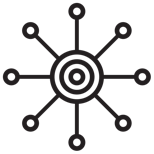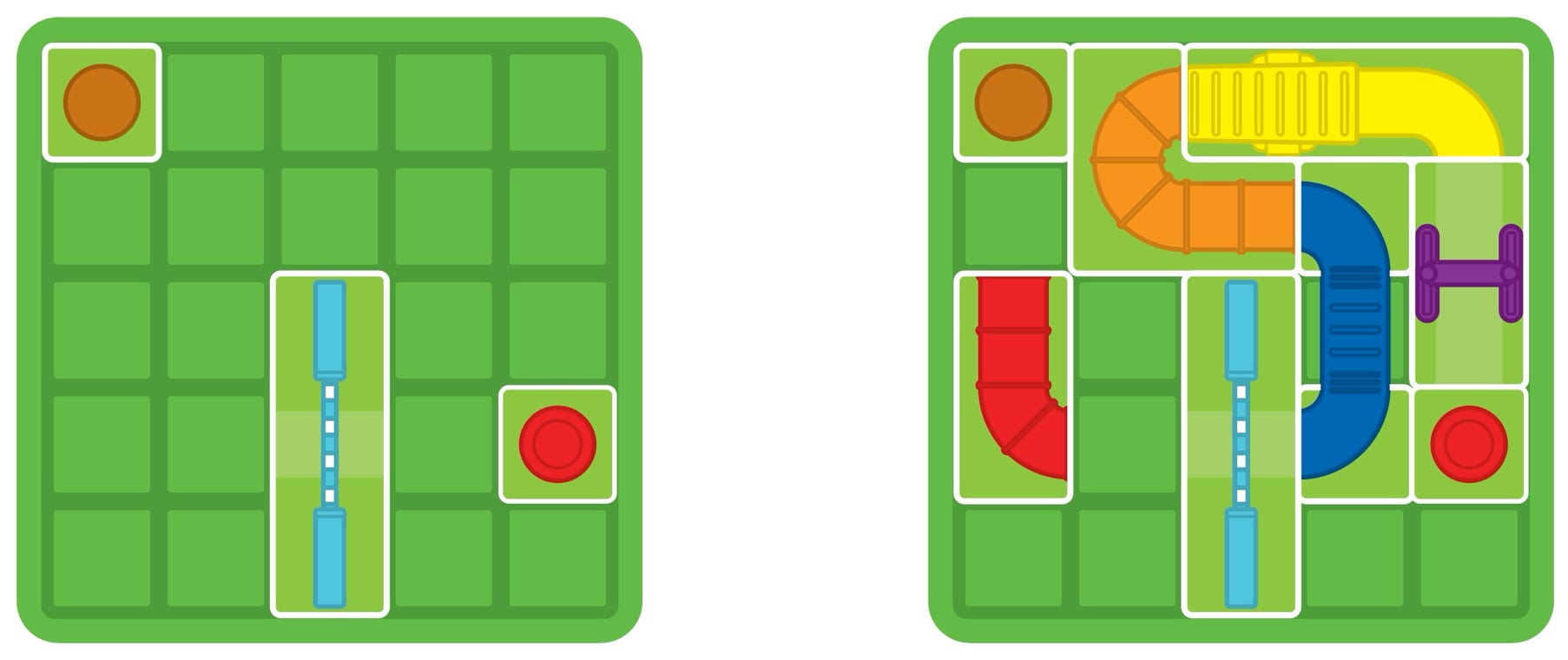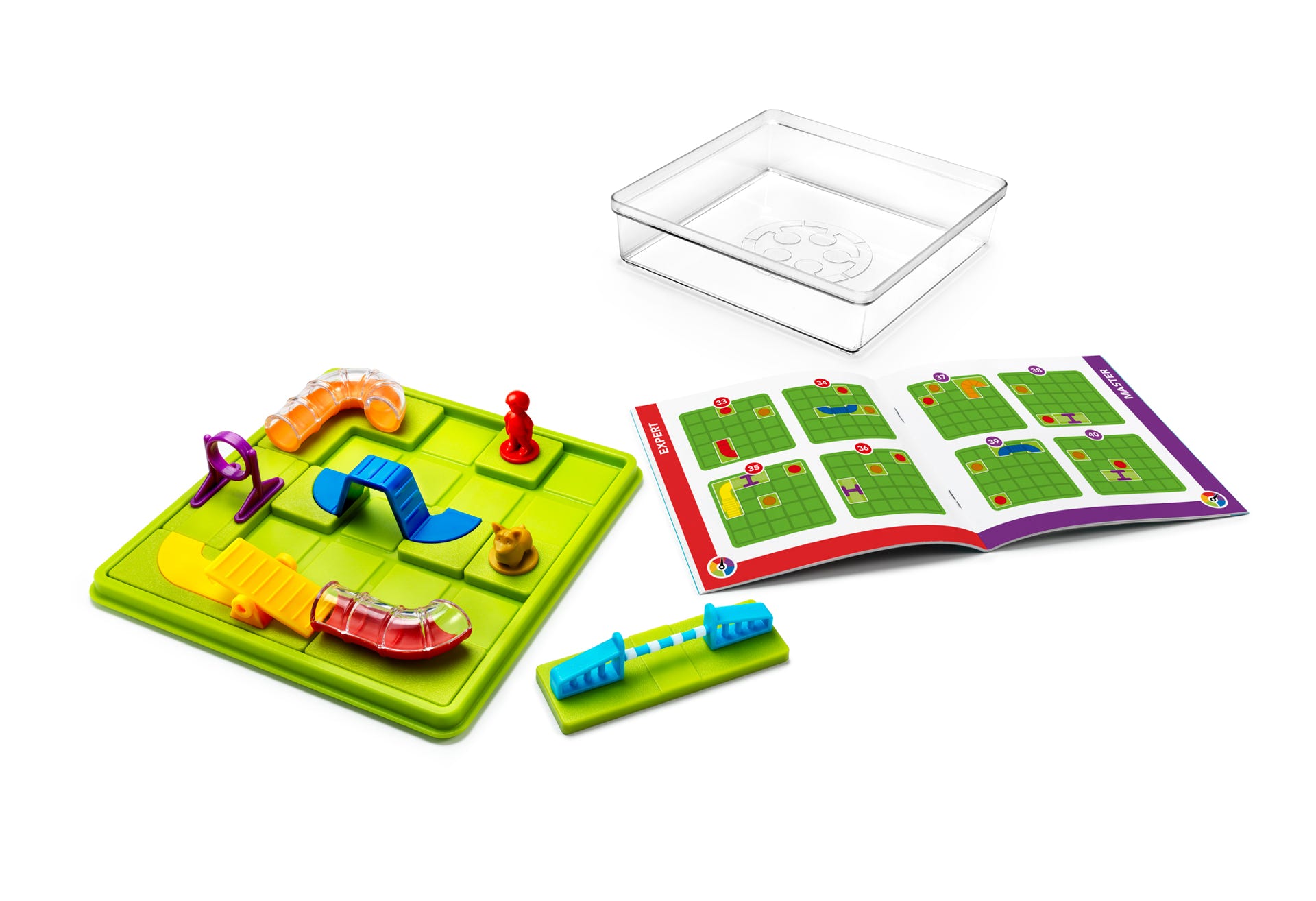
Smart Dog
The product development of SmartDog (for SmartGames)
Raf Peeters, January 2024

Smart Dog started as a connection game featuring houses, roads and cars, initially designed to fit inside a tin box similar to Turtle Tactics or LogiBugs. But for several reasons we didn’t like it. It had too many (small) parts and if you didn’t position everything perfectly on the game board, it looked a bit chaotic. I believe it was my colleague Leighton who proposed a change in theme to a dog agility course (he owns a dog). I am more a cat person, so I don’t know anything at all about dogs (and I prefer to keep it that way), but Google provided ample inspiration. The interesting aspect of this theme, aside from the dog, is that it includes various colored obstacles, such as a bridge, tubes, and a hoop. This gave us enough elements to work with to make it a visually appealing game.
Once the theme was decided, the game's development proceeded smoothly. My boss liked it but he suggested a shift from a tin box format to a compact game akin Cats & Boxes. The fact that that game is a huge success might have something to do with it. But changing the format also resolved the chaotic look, because now the game board has a grid with grooves, keeping all the puzzle pieces perfectly aligned.
Originally, the human figurine was pink, but we opted to change it to red in the final design to avoid a overly girlish appearance. We made the figurine neutral enough to represent either a boy or a girl. The design of the dog was not designed by Leighton but by Rein, who had previously created it for another project. Apparently it’s a corgi, like the dog of Queen Elisabeth. All fine for me, because it looked cute. Both figurines can rotate on their puzzle pieces to symbolize that they don’t have a specific orientation. A path can start in any horizontal or vertical direction from the dog. What distinguishes this game from most other connection games is that the path pieces don't need to be placed adjacent to each other. It’s like driving school: when no instructions are given, you need to continue straight ahead. This means that you often use empty parts of the game board to go from one obstacle to the next. Sometimes you cross the same square on the grid twice, each time coming from a different angle. The yellow seesaw is the only obstacle with a specific direction; the dog must start at its low end. The seesaw automatically tilts to the front side because that part is slightly longer and heavier. But in case you don’t play the game on a perfectly horizontal surface, there is also a small triangle on the yellow path indicating the right direction for the dog. I particularly like the transparent tubes as they give the game some depth and make it look more expensive. The purple hoop and the light blue jump don’t alter the path’s direction, so their sole purpose in the game is to make things harder. You need to find enough empty space somewhere along the path to place these pieces. To prevent that people would cross these puzzle pieces in the wrong orientation, both obstacles have big supporting feet.
While both games are connection games, Smart Dog differs from Horse Academy in several ways. Firstly, it features only one continuous path without any forks. Secondly, puzzle pieces do not need to be adjacent. Thirdly, players must use all obstacles in Smart Dog, but the order in which they are tackled doesn't matter. As always, determining the right name posed more challenges than any other aspect of product development. We considered "Doggo," "Max," "Obstacle Run," "Puzzle Paws," and many others. However, if consensus on a single name proves impossible, the final choice typically begins with "Smart…”. Now you also understand why the company I work for has so many products and brand names incorporating that word ;-). Smart Dog will be available in Spring 2024.

Example of a challenge (left) and solution (right) of Smart Dog

GAME RULES SMART DOG
1) Choose a challenge. Place the dog and its trainer on their indicated positions on the game board.
2) Place all obstacles on the game board to create a path from the dog to the trainer that uses every obstacle once:
A. The dog must move horizontally or vertically from square to square on the game board (not diagonally). The path can start at the dog in any direction.
B. The path for the dog will follow a straight line, until the direction of this path is changed by a curved obstacle (yellow, orange, red or dark blue). The purple and light blue obstacles don't change the direction of the path.
C. The path for the dog can arrive at the trainer from any direction.
D. The path for the dog can go over empty squares of the game board in any direction horizontally or vertically. Sometimes it will cross the same square on the game board twice (but coming from a different direction).
E. On each puzzle piece, the dog’s path should follow the direction given by the obstacle.
F. With the yellow obstacle you must follow the direction of the arrow so that the path starts at the low end of the seesaw.
G. The path can go underneath the dark blue bridge. The straight parts of the orange and red tube will fit underneath this bridge. The left and right side of the light blue obstacle also fits underneath the bridge, but the central part with the path does not. The yellow and purple obstacles never fit under the bridge.
H. Easier challenges show the correct position of some obstacles. These positions cannot be changed.
3) There is only one solution, which you can find back at the end of the booklet.
Website ©2024 Raf Peeters
Products and images: © Smart